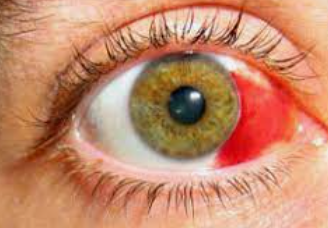If you’ve noticed blood on the outside of your eye, it is most likely a subconjunctival hemorrhage.
In a large population-based survey (Nationwide Study in Taiwan from 2000 to 2011), the mean annual incidence was quoted as 6.5 per 1,000 people.
While bleeding on the outside of your eye might appear dramatic, a subconjunctival hemorrhage is only a broken tiny blood vessel on the surface of the white part of your eye, the conjunctiva.
What is a subconjunctival hemorrhage?
The eye’s conjunctiva is a clear layer that protects the front part of your eye and is usually clear but may at times show tiny blood vessels, which are actually capillary sized. These tiny fragile blood vessels are usually not present, and the eye appears white and clear.
However, the conjunctival blood vessels might appear due to allergies, dry eyes, a head cold or even if you have taken a little too much alcohol or recreational drugs.
These delicate vessels may break and bleed and are also unable to absorb blood very quickly, so the blood sometimes remains on the eye for several days. While these bright red blood spots look scary, they are usually harmless and often heal on their own.
If you suspect you have a subconjunctival hemorrhage, contact an eye doctor near you.
SEE RELATED: Does Smoking Affect the Eyes?
What causes a subconjunctival hemorrhage?
Usually the only symptom of subconjunctival hemorrhage is a red spot in your eye. You might not even realize you have it until you look in the mirror. It’s also possible that you’ll feel minor eye irritation from time to time.
The most common causes of the blood seen on the eye due to subconjunctival hemorrhages include;
- Coughing
- Sneezing
- Vomiting
- Physical strain
- Eye trauma
- Rubbing eyes too hard
As these actions briefly raise the blood pressure in your veins, they can cause these fragile capillaries to break.
Other causes of subconjunctival hemorrhage is blunt trauma to the eye or even rubbing your eyes too hard.
Health issues that can lead to subconjunctival hemorrhage include:
- Diabetes
- High blood pressure
- Anticoagulant medicines that can cause you to bleed easily
In rare cases, subconjunctival hemorrhage is caused by a blood clotting disorder or other blood problem that affects your whole body.
How to treat subconjunctival hemorrhage?
Depending on how large the bleeding is or the size of the blood spot, a subconjunctival hemorrhage could heal on its own without treatment. It may take a few days or a few weeks.
It is important for an eye doctor to determine the cause of the blood on your eye.
Using artificial tears can help relieve any eye irritation you may feel.
LEARN MORE: Guide to Eye Health
If you notice blood on your eye, it may be a subconjunctival hemorrhage, schedule an appointment with an eye doctor near you to discuss further testing and the options to reduce your risks of this worrying condition.


